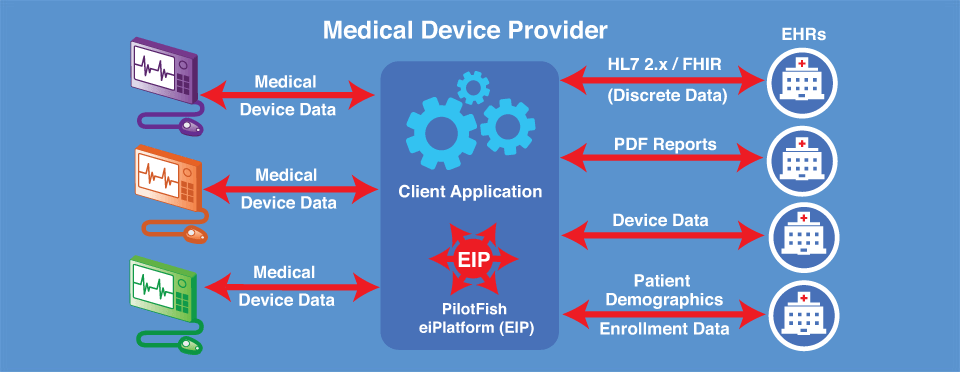Medical Device Integration Engine for HL7, FHIR and IHE PCD Integration
PilotFish’s low-code engine speeds medical device connectivity with visual configuration, automated Assembly Line, and drag-and-drop mapping. Support for HL7, FHIR, IHE PCD and IEEE 11073 with HIPAA/NIST-aligned security. Proven at scale, modular architecture supports high availability and new device types without rework. Delivers high-quality data to EHRs and downstream mobile apps in near real time.
Why PilotFish for Medical Device Connectivity
The PilotFish Integration Engine’s low-code/no-code solution connects virtually any type of device – including bedside devices, monitors and wearables – to any EHR/EMR and analytics stack, without requiring custom code.
PilotFish’s visual, automated Assembly Line, with out-of-the-box listeners/adapters and graphical drag-and-drop mapping, shortens integration cycles from weeks to days.
- Faster delivery: Low-code Assembly Line, reusable templates and inline testing speed builds and updates. Frees up IT resources and accelerates rollouts.
- Full Standards Support: HL7 v2.x (ADT/ORM/ORU), DICOM, FHIR (Device, Observation, DeviceMetric), IHE PCD-01 DEC, IEEE 11073/SDC, X12 EDI, terminologies LOINC and SNOMED
- Data Validation & Cleansing: Built-in processors validate, cleanse, and normalize medical device data to ensure high-integrity inputs and reliable outputs.
- Vendor Neutral: Connects to Epic, Cerner/Oracle Health, Meditech, athenahealth and modern analytics stacks
- AI-ready data: Validated, normalized, clean device data routed to EHRs, data warehouses and alerting engines
- Cost Efficiencies: Intuitive, easy-to-use configuration and “self-documenting” features allow non-technical staff to configure, manage and maintain interfaces.
- Future-Proofed: PilotFish’s modular architecture ensures scalability, high availability, and support for new device types and standards.
Security & Compliance
Meets strict data and privacy regulations. Supports TLS/mTLS, encryption/decryption processors, role-based access, multi-factor authentication, and comprehensive audit logging.
Deployment Anywhere
Runs on-premises, in VMs or containers. Optimized for Docker and Kubernetes with externalized configuration and CI/CD-ready artifacts.
Transparent Licensing Options
PilotFish offers on-demand and one-time licensing, without charging per transaction, interface, or connection. PilotFish’s model typically results in substantial cost savings.
Comprehensive Integration Product Suite: PilotFish’s cohesive suite of integration products includes our eiPlatform (engine), eiConsole (IDE), and eiDashboard (monitoring and reporting tool), providing a comprehensive solution for the entire integration lifecycle.

Medical Device Workflow Integration Example using PilotFish Middleware
How PilotFish’s Automated Assembly Line Works
![]()
7 Stages to Build an Interface in PilotFish eiConsole
Interfaces are rapidly built, managed and maintained with automated functions at each stage.
- Ingest: Listeners/adapters capture device messages and signals. Format Builders simplify schema generation. Protocols include RS-232/serial, TCP, MQTT, REST and vendor APIs.
- Validate & Cleanse: Built-in processors normalize and validate payloads
- Map: Graphical drag & drop transforms (e.g., ORU_R01 to FHIR Device/Observation/DeviceMetric)
- Route: Rules deliver to EHRs, data lakes, analytics and mobile apps
- Test Inline: Test at any stage or end-to-end, real-time validation and debugging before deployment
- Deploy: CI/CD, containers, rollbacks, versioned routes
- Observe: Logging, auditing and alerts ensure quality and uptime
Virtually any standard can be supported using the identical low-code, no-code automated PilotFish graphical configuration process. Our native XML support ensures you can handle any future healthcare standard.
PilotFish: Medical Device Interoperability Delivered
PilotFish’s tools and built-in expertise dramatically simplify the interoperability of medical device data across the healthcare ecosystem. The results:
- Reduced interface build and onboarding times from weeks to days
- Greater efficiencies with reusable components and versioned artifacts
- Higher data quality for clinical workflows, analytics and AI
With proven solutions tailored to medical device connectivity – PilotFish enables faster implementation times, lower resource utilization and reduced costs.
Free 90-Day Trial
Take advantage of PilotFish’s full, FREE 90-Day Trial Version of our software. You can complete an end-to-end interface in less than 20 minutes and get a real sense of the ease-of-use of PilotFish’s Interface Engine solutions. Talk to our team about IHE PCD-01/HL7 ORU mapping, FHIR Device/Observation and deployment patterns. We’re ready to answer any question.
FAQ
PCD-01 standardizes the flow of personal care device observations to enterprise systems (EHR, CDS), improving consistency and interoperability. The DEC IHE PCE profile communicates physiologic and operational data.
PilotFish maps IEEE 11073/SDC concepts to HL7 v2 and FHIR resources, allowing physiologic data to be normalized and routed to downstream systems.
We support encryption/mTLS, RBAC/MFA, audit logging and update processes that align with the latest FDA premarket cybersecurity guidance (e.g., SBOM, TPLC practices).
Any system with compatible interfaces (e.g., HL7 v2, FHIR, APIs) including Epic, Cerner/Oracle Health, Meditech and modern analytics stacks.
Infusion pumps, ventilators, anesthesia machines, physiologic monitors, telemetry, POCT analyzers, wearables. Protocols include RS-232/serial, TCP, MQTT, REST and vendor APIs.
Related Case Studies
- Multi-Vendor HL7 Integration
Across a hospital group, real-time clinical data integration message transformations facilitated smooth communication with disparate systems, including Meditech, UniPOC, Omnicell and PACS. - EHR HL7 Medical Device Integration
Leader in wearable cardiac telemetry and mobile health solutions migrated its EHR interfaces, streamlined integration with healthcare providers, and significantly reduced both technical complexity and long-term costs. - Medical Equipment EHR Integration Solution
Leading provider of medication management solutions rolled out a single, consistent integration approach to support a growing client base of globally dispersed automated medication management environments.
Explore additional healthcare integration case studies.
If you’re curious about the software features, free trial, or even a demo – we’re ready to answer any and all questions. Please call 813 864 8662 or click the button.
HL7 is the registered trademark of Health Level Seven International.
X12, chartered by the American National Standards Institute for more than 35 years, develops and maintains EDI standards and XML schemas.
